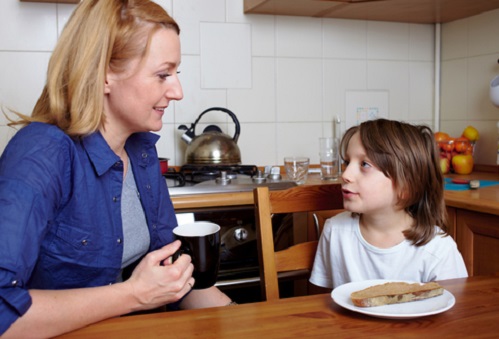Talk, Talk, Talk…and Talk Some More
Writing comes from thinking. Thinking is expressed in several ways:
Action (you act on the thought: Toothbrush into mouth to clean teeth)
Speech (you speak the thought: “Hand me my toothbrush.”)
Writing (you fingerwrite a note on the steamy bathroom mirror: “Where did you put my toothbrush, goofball?”)
Because writing is the transcription of thoughts into words, we need to recognize all three components and help our kids make the connections.
For instance, action often occurs without much “word-conscious” thought. We go about our business without narrating it to ourselves in words. We might walk to the refrigerator to get a carton of milk, but are thinking about when we get the next turn on the Wii to play Dance Revolution. At least, this is what is happening for our kids. Both require thought, but one is thought in words and the other is thought in activity.
One way you can help your kids grow into writers is to help them narrate their actions and thoughts with words (spoken words). By speaking words: “Let’s see, I need to brush my teeth before I put on my pajamas and before Jordan hides my toothbrush again,” you help your child to use language for thinking.
You model the narrating of life in front of your kids. Literally be the crazy lady or man who talks to self: “I need to pick up the dry cleaning before I call the arena to buy the football tickets.”
Some kids (particularly math/science kids, or those who are introverted, or speech-delayed) find it most difficult to speak their thoughts. They can do them more easily (punch the offending party, slam a door, open the bottle of 7Up, toss a football, take the dog for a walk, roll around on the floor in frustration).
Your job with your kids is to talk: talk, talk, talk, talk. Name what you see (without judgment) giving the action language:
“I see you rolling around on the floor. You were just playing a game. What happened?”
Get the story. Try not to evaluate what you see; allow your child to find words. You can help as he or she works it out.
“Are you frustrated? Angry? Worried? Did someone misunderstand you?”
You can’t reel these off in a list, but you can ask them gently over time. You can help the child to sort the action into feeling words.
Feelings aren’t the only “thoughts without words” that kids experience though (and mothers often think this is the height of child self-awareness, but articulating feelings are only one piece of the thought-without-language puzzle).
Sometimes kids need help puzzling through actions and sequences of those actions in words.
“Okay, you’ve finished breakfast. Let’s go over what will happen today. Catie, what do we do next this morning? What comes after that? When will we eat lunch? How many hours until lunch then? Okay, so how much time do you think we have for reading and copywork? Is there time for you to play Candy Crush now or later in the day?”
That’s a dense word-picture of how to engage through words, but these comments can be items in a dialog of conversation back-and-forth, back-and-forth. Your goal is to lead your child into language for action and thought. So your child, who mostly operates without a clock and let’s you initiate all the activities of the day, can now begin to put words to those activities, can be called on to calculate time frames, can sequence the events of the day, can examine how her desires fit into the structure of home education. All in language.
How does this help with writing? Kids need practice sequencing, naming emotion, evaluating priorities, planning in words. These are all skills that go into the production of papers and detailed examination of other processes and sequences.
Your job, as a home educator, is to talk your mouth off! You want to talk, talk, talk, narrating—probing in a gentle, genuinely curious way, lending words and vocabulary to your fledgling thought-generator.
You do so much automatically, as though you’ve always lived from this ease-of-thought to action and word, you forget that you need to train your kids in these practices. The more your children explore language for ideas, thoughts, actions, experiences, sequences, priorities, plans, and connections, the more language will be available to them when they go to writing. Count on it.
You’ll also have models to draw from: “Remember when you were frustrated? How did you show that to me? How did I know? Exactly: you were yelling at the computer screen. How might you use that action to show General Washington’s frustration when he….?”
You might say, “Remember when we figured out how to plan the day so you had time to play your favorite game? We saved the game for last. ‘Emphatic order’ is kind of like that: you save the best argument for last…”
This is how it works—a dialog between one’s natural life and language, leading to an application of all that narrating to writing.
Shared on Hip Homeschool Moms.
Top image © Miszaqq | Dreamstime.com



















